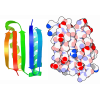+ Open data
Open data
- Basic information
Basic information
| Entry | Database: PDB / ID: 1m1d | ||||||
|---|---|---|---|---|---|---|---|
| Title | TETRAHYMENA GCN5 WITH BOUND BISUBSTRATE ANALOG INHIBITOR | ||||||
 Components Components |
| ||||||
 Keywords Keywords | TRANSFERASE / Histone Acetyltransferase / Gcn5-related N-acetyltransferase / inhibitor complex / transcription factor | ||||||
| Function / homology |  Function and homology information Function and homology informationchromatin organization => GO:0006325 / sexual sporulation resulting in formation of a cellular spore / cupric reductase (NADH) activity / global genome nucleotide-excision repair / RNA polymerase I upstream activating factor complex / Condensation of Prophase Chromosomes / : / : / Assembly of the ORC complex at the origin of replication / replication fork protection complex ...chromatin organization => GO:0006325 / sexual sporulation resulting in formation of a cellular spore / cupric reductase (NADH) activity / global genome nucleotide-excision repair / RNA polymerase I upstream activating factor complex / Condensation of Prophase Chromosomes / : / : / Assembly of the ORC complex at the origin of replication / replication fork protection complex / histone H3 acetyltransferase activity / Oxidative Stress Induced Senescence / RNA Polymerase I Promoter Escape / positive regulation of transcription by RNA polymerase I / nucleolar large rRNA transcription by RNA polymerase I / Estrogen-dependent gene expression / rRNA transcription / histone acetyltransferase complex / intracellular copper ion homeostasis / histone acetyltransferase / CENP-A containing nucleosome / aerobic respiration / structural constituent of chromatin / nucleosome / chromatin organization / protein heterodimerization activity / regulation of DNA-templated transcription / positive regulation of transcription by RNA polymerase II / DNA binding / nucleus Similarity search - Function | ||||||
| Biological species |  | ||||||
| Method |  X-RAY DIFFRACTION / X-RAY DIFFRACTION /  SYNCHROTRON / SYNCHROTRON /  MOLECULAR REPLACEMENT / Resolution: 2.2 Å MOLECULAR REPLACEMENT / Resolution: 2.2 Å | ||||||
 Authors Authors | Poux, A.N. / Cebrat, M. / Kim, C.M. / Cole, P.A. / Marmorstein, R. | ||||||
 Citation Citation |  Journal: Proc.Natl.Acad.Sci.USA / Year: 2002 Journal: Proc.Natl.Acad.Sci.USA / Year: 2002Title: Structure of the GCN5 histone acetyltransferase bound to a bisubstrate inhibitor. Authors: Poux, A.N. / Cebrat, M. / Kim, C.M. / Cole, P.A. / Marmorstein, R. | ||||||
| History |
| ||||||
| Remark 600 | HETEROGEN INHIBITOR COMPOSED OF A HISTONE H3 FRAGMENT (RESIDUES 1-20) AND A COENZYME A MOLECULE ...HETEROGEN INHIBITOR COMPOSED OF A HISTONE H3 FRAGMENT (RESIDUES 1-20) AND A COENZYME A MOLECULE COVALENTLY BOUND THROUGH AN ISOPROPIONYL LINKER TO LYS14. | ||||||
| Remark 999 | SEQUENCE Residue 90 (Chain A) and residue 390 (Chain C) are both PHE. Author indicates that PHE is ...SEQUENCE Residue 90 (Chain A) and residue 390 (Chain C) are both PHE. Author indicates that PHE is present in many of the GCN5 homologues at that position. According to the author, residue 210 (Chain A) and residue 510 (Chain C) are both ARG and not ASN. |
- Structure visualization
Structure visualization
| Structure viewer | Molecule:  Molmil Molmil Jmol/JSmol Jmol/JSmol |
|---|
- Downloads & links
Downloads & links
- Download
Download
| PDBx/mmCIF format |  1m1d.cif.gz 1m1d.cif.gz | 86.9 KB | Display |  PDBx/mmCIF format PDBx/mmCIF format |
|---|---|---|---|---|
| PDB format |  pdb1m1d.ent.gz pdb1m1d.ent.gz | 65.6 KB | Display |  PDB format PDB format |
| PDBx/mmJSON format |  1m1d.json.gz 1m1d.json.gz | Tree view |  PDBx/mmJSON format PDBx/mmJSON format | |
| Others |  Other downloads Other downloads |
-Validation report
| Summary document |  1m1d_validation.pdf.gz 1m1d_validation.pdf.gz | 389.4 KB | Display |  wwPDB validaton report wwPDB validaton report |
|---|---|---|---|---|
| Full document |  1m1d_full_validation.pdf.gz 1m1d_full_validation.pdf.gz | 409 KB | Display | |
| Data in XML |  1m1d_validation.xml.gz 1m1d_validation.xml.gz | 12.6 KB | Display | |
| Data in CIF |  1m1d_validation.cif.gz 1m1d_validation.cif.gz | 16.8 KB | Display | |
| Arichive directory |  https://data.pdbj.org/pub/pdb/validation_reports/m1/1m1d https://data.pdbj.org/pub/pdb/validation_reports/m1/1m1d ftp://data.pdbj.org/pub/pdb/validation_reports/m1/1m1d ftp://data.pdbj.org/pub/pdb/validation_reports/m1/1m1d | HTTPS FTP |
-Related structure data
| Related structure data | 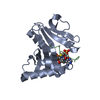 1qsnS S: Starting model for refinement |
|---|---|
| Similar structure data |
- Links
Links
- Assembly
Assembly
| Deposited unit | 
| ||||||||
|---|---|---|---|---|---|---|---|---|---|
| 1 | 
| ||||||||
| 2 | 
| ||||||||
| Unit cell |
|
- Components
Components
| #1: Protein | Mass: 19457.658 Da / Num. of mol.: 2 / Fragment: Catalytic Domain Source method: isolated from a genetically manipulated source Source: (gene. exp.)   References: GenBank: 1245146, UniProt: Q27198*PLUS, Transferases; Acyltransferases; Transferring groups other than aminoacyl groups #2: Protein/peptide | Mass: 3011.146 Da / Num. of mol.: 2 Fragment: 20 MER PEPTIDE (RESIDUES 1-20), Bisubstrate analog Source method: obtained synthetically Details: Inhibitor composed of a histone H3 fragment (residues 1-20) is chemically synthesized. The peptide's sequence occurs naturally in Saccharomyces cerevisiae (Baker's yeast). References: UniProt: P02303, UniProt: P61830*PLUS #3: Water | ChemComp-HOH / | Has protein modification | Y | |
|---|
-Experimental details
-Experiment
| Experiment | Method:  X-RAY DIFFRACTION / Number of used crystals: 1 X-RAY DIFFRACTION / Number of used crystals: 1 |
|---|
- Sample preparation
Sample preparation
| Crystal | Density Matthews: 1.89 Å3/Da / Density % sol: 35.09 % | ||||||||||||||||||||||||||||||||||||||||||
|---|---|---|---|---|---|---|---|---|---|---|---|---|---|---|---|---|---|---|---|---|---|---|---|---|---|---|---|---|---|---|---|---|---|---|---|---|---|---|---|---|---|---|---|
| Crystal grow | Temperature: 298 K / Method: vapor diffusion, hanging drop / pH: 6.6 Details: Ammonium sulfate, sodium cacodylate, sodium chloride, pH 6.6, VAPOR DIFFUSION, HANGING DROP, temperature 298K | ||||||||||||||||||||||||||||||||||||||||||
| Crystal grow | *PLUS Temperature: 20 ℃ | ||||||||||||||||||||||||||||||||||||||||||
| Components of the solutions | *PLUS
|
-Data collection
| Diffraction | Mean temperature: 95 K |
|---|---|
| Diffraction source | Source:  SYNCHROTRON / Site: SYNCHROTRON / Site:  APS APS  / Beamline: 19-ID / Wavelength: 1.0082 Å / Beamline: 19-ID / Wavelength: 1.0082 Å |
| Detector | Type: CUSTOM-MADE / Detector: CCD / Date: Feb 22, 2001 |
| Radiation | Monochromator: Rosenbaum-Rock / Protocol: SINGLE WAVELENGTH / Monochromatic (M) / Laue (L): M / Scattering type: x-ray |
| Radiation wavelength | Wavelength: 1.0082 Å / Relative weight: 1 |
| Reflection | Resolution: 1.9→50 Å / Num. all: 27647 / Num. obs: 26519 / % possible obs: 96.1 % / Observed criterion σ(I): -3 |
| Reflection shell | Resolution: 2.2→2.28 Å / % possible all: 97.7 |
| Reflection | *PLUS Highest resolution: 2.2 Å / Lowest resolution: 37.3 Å / % possible obs: 99.2 % / Rmerge(I) obs: 0.059 |
| Reflection shell | *PLUS Highest resolution: 2.2 Å / % possible obs: 97.7 % / Rmerge(I) obs: 0.346 / Mean I/σ(I) obs: 5 |
- Processing
Processing
| Software |
| ||||||||||||||||||||
|---|---|---|---|---|---|---|---|---|---|---|---|---|---|---|---|---|---|---|---|---|---|
| Refinement | Method to determine structure:  MOLECULAR REPLACEMENT MOLECULAR REPLACEMENTStarting model: PDB ENTRY 1QSN Resolution: 2.2→50 Å / Isotropic thermal model: anisotropic / Cross valid method: THROUGHOUT / σ(F): 2 / Stereochemistry target values: Engh & Huber
| ||||||||||||||||||||
| Displacement parameters |
| ||||||||||||||||||||
| Refinement step | Cycle: LAST / Resolution: 2.2→50 Å
| ||||||||||||||||||||
| Refinement | *PLUS Lowest resolution: 37.3 Å / % reflection Rfree: 10 % / Rfactor all: 0.271 / Rfactor obs: 0.26 / Rfactor Rfree: 0.2652 / Rfactor Rwork: 0.2134 | ||||||||||||||||||||
| Solvent computation | *PLUS | ||||||||||||||||||||
| Displacement parameters | *PLUS | ||||||||||||||||||||
| Refine LS restraints | *PLUS
|
 Movie
Movie Controller
Controller





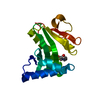

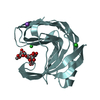

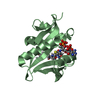

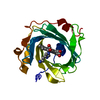



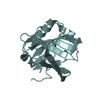

 PDBj
PDBj



